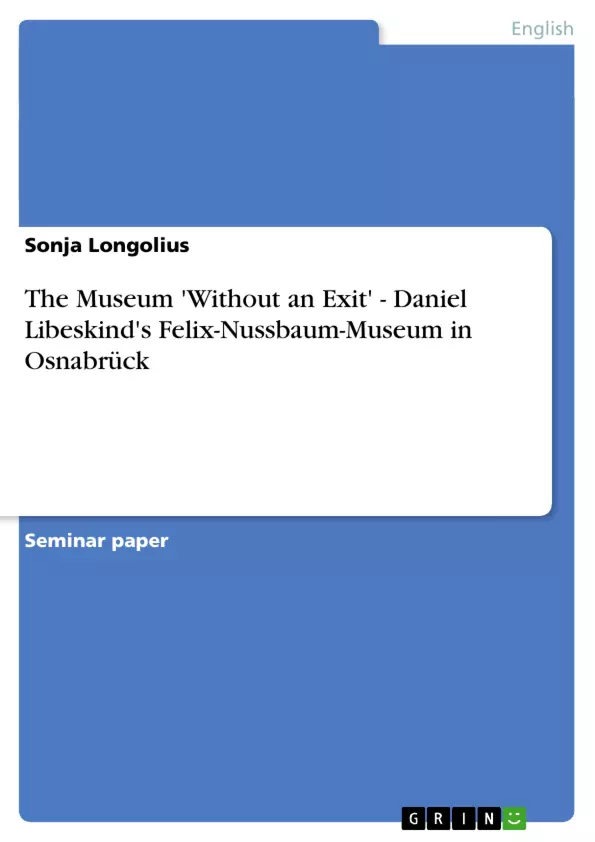"If I perish, don’t let my paintings die, exhibit them!" While speaking these words in his Belgian exile in 1942, Felix Nussbaum did not know that he had only two more years to live until the terror regime of National-Socialism would murder him and his wife, Felka Platek, in Auschwitz. Being only forty years of age when murdered, the artist seemed to have abandoned all hope after being forced to live in exile and under constant threat of discovery since 1933. Nevertheless, this personal hopelessness did not include the destiny of his artwork, for which Felix Nussbaum cared as long as possible.
"The unpainted paintings of Felix Nussbaum demand nothing less than to become visible to the contemplating eye" and so Daniel Libeskind built a museum in Osnabrück to house the largest collection of Nussbaum’s paintings as well as to create "a profound place for the encounter of the future and the past and not only a testament to an impossible fate." In July 1998, 54 years after Felix Nussbaum’s deportation to Auschwitz, the museum opened its gates to the public.
"The Museum without an Exit", as Daniel Libeskind coined his building, challenges the traditional idea of museums as “Temples of Contemplation.” Libeskind insists on emotional and physical experiences evoked when entering the museum’s space. His difficult building does not allow visitors to be passive spectators, since the museum does not simply offer space for distributing works of art. Rather, Libeskind’s building urges people to get closer to the experience of Felix Nussbaum and hence sets new standards in regard of museum-building.
Inhaltsverzeichnis (Table of Contents)
- Introduction
- Felix Nussbaum - The Painter
- The Kulturgeschichtliches Museum and its Nussbaum-Collection
- Daniel Libeskind – The Architect
- The 'Museum without an Exit'
- Numbers and Facts
- Passage, House, and Bridge – Three Parts of One Building
- The architectural concept of the 'Museum without an Exit'
- Conclusion
Zielsetzung und Themenschwerpunkte (Objectives and Key Themes)
This term paper aims to explore the historical context and artistic significance of Felix Nussbaum's paintings, as well as the architectural design of the Felix-Nussbaum-Museum in Osnabrück, which houses a substantial portion of Nussbaum's work. The paper delves into the life and career of the artist, emphasizing his experiences during the Nazi regime and his legacy as an artist of the “Forgotten Generation.” It then examines the museum’s architectural concept, focusing on its unique design and its ability to create an immersive experience for visitors.
- The life and artistic development of Felix Nussbaum
- The impact of the Nazi regime on Nussbaum's life and art
- The historical context of Nussbaum's work within the "Forgotten Generation" of artists
- The architectural design of the Felix-Nussbaum-Museum in Osnabrück
- The museum's unique approach to creating a meaningful visitor experience
Zusammenfassung der Kapitel (Chapter Summaries)
- Introduction: This chapter introduces Felix Nussbaum and his legacy as a painter who continued to create art despite the dire circumstances of his exile during the Nazi era. The chapter also introduces the Felix-Nussbaum-Museum and its significance as a testament to Nussbaum's work and as a space for reflection on the past and future.
- Felix Nussbaum - The Painter: This chapter provides biographical details about Felix Nussbaum's life and artistic career, focusing on his early works, his studies, and his eventual exile due to the rise of the Nazi regime. It highlights the themes of assimilation and Jewish identity in his work, culminating with his tragic fate in Auschwitz.
- The Kulturgeschichtliches Museum and its Nussbaum-Collection: This chapter explores the history of the Kulturgeschichtliches Museum Osnabrück, tracing its development as a cultural institution. It also discusses the museum's significant collection of Felix Nussbaum's works, emphasizing the importance of preserving his legacy.
- The 'Museum without an Exit': This chapter presents the architectural design of the Felix-Nussbaum-Museum, focusing on its three main components: passage, house, and bridge. The chapter discusses the unique design and its aim to create an immersive and emotionally engaging experience for visitors.
Schlüsselwörter (Keywords)
The paper explores the key topics of Felix Nussbaum's life and artistic legacy, the "Forgotten Generation" of artists, the impact of the Nazi regime, the concept of "Museum without an Exit," and the architectural design of the Felix-Nussbaum-Museum in Osnabrück.
- Quote paper
- Sonja Longolius (Author), 2003, The Museum 'Without an Exit' - Daniel Libeskind's Felix-Nussbaum-Museum in Osnabrück, Munich, GRIN Verlag, https://www.grin.com/document/41727



